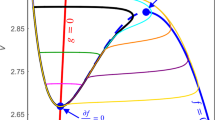Summary
The observation of various types of spatio-temporal correlations in spike-patterns of multiple cortical neurons has shifted attention from rate coding paradigms to computational processes based on the precise timing of spikes in neuronal ensembles. In the present work we develop the notion of “spatial” and “temporal interaction” which provides measures for statistical dependences in coupled stochastic processes like multiple unit spike trains. We show that the classical Willshaw network and Abeles’ synfire chain model both reveal a moderate spatial interaction, but only the synfire chain model reveals a positive temporal interaction, too. Systems that maximize temporal interaction are shown to be almost deterministic globally, but posses almost unpredictable firing behavior on the single unit level.
Similar content being viewed by others
References
Abeles, M. (1991) Corticonics: Neural circuits of the cerebral cortex. Cambridge University Press, Cambridge UK.
Aertsen, A. M. H. J.; Gerstein, G. L.; Habib, M. K. and Palm, G. (1989) Dynamics of Neuronal Firing Correlation: Modulation of “Effective Connectivity”. J. Neurophysiol. 61: 900–917.
Amari, S.-I. (2001) Information Geometry on Hierarchy of Probability Distributions. IEEE Trans. Information Theory 47: 1701–1711.
Amit, D. J. (1995) The Hebbian Paradigm Reintegrated: Local Reverberations as Internal Representations. Beh. Brain Sci. 18: 617–657.
Ay, N. (2002a) An Information-Geometric Approach to a Theory of Pragmatic Structuring. Annals of Probability 30: 416–436.
Ay, N. (2002b) Locality of Global Stochastic Interaction in Directed Acyclic Networks. Neural Comput. 14: 2959–2980.
Ay, N. (2003) Information Geometry on Complexity and Stochastic Interaction. IEEE Trans. Information Theory, submitted.
Ay, N.; Wennekers, T. (2003) Dynamical Properties of Strongly Interacting Markov Chains. Neural Networks, submitted.
Bliss, T. V. P. and Collingridge, G. L. (1993) A synaptic model of memory: long-term potentiation in the hippocampus. Nature 361: 31–39.
Cover, T. M. and Thomas, J. A. (1991) Elements of Information Theory. Wiley Series in Telecommunications. New York: Wiley-Interscience.
Dayan, P. and Abbott, L. F. (2001) Theoretical Neuroscience. MIT-Press, Cambridge, MA.
Eckhorn, R. (1999) Neural mechanisms of scene segmentation: Recordings from the visual cortex suggest basic circuits for linking field models. IEEE Trans. Neural Networks 10: 464–479.
Fuster, J. M. (1994) Memory in the cerebral cortex. MIT Press, Cambridge.
Grün, S.; Diesmann, M. and Aertsen, A. (2002) Unitary events in multiple single-neuron spiking activity: I. Detection and significance. Neural Comput. 14: 43–80. II. Nonstationary data. Neural Comput. 14: 81–119.
Hebb, D. O. (1949) The organization of behavior. Wiley, New York.
Linsker, R. (1988) Self-organization in a perceptual network. IEEE Computer 21, 105–117.
Martignon, L.; von Hasseln, H.; Grün, S.; Aertsen, A. and Palm, G. (1995) Detecting higher-order interactions among the spiking events in a group of neurons. Biol. Cybern. 73: 69–81.
Nakahara, H. and Amari, S. (2002) Information geometric measure for neural spike trains. Neural Comput. 14: 2269–2316.
Nicolelis, M. A. L., and De Schutter, E. (2001) Special Issue on Multiple Electrode Recordings. J. Neurosci. Meth. 94(1): 3–154.
Palm, G. (1982) Neural Assemblies. An Alternative Approach to Artificial Intelligence, Springer Verlag, Berlin.
Rieke, F., Warland, D., Ruyter van Steveninck, R. and Bialek W. (1998) Spikes: Exploring the Neural Code. MIT Press, Cambridge.
Singer, W. and Gray, C. M. (1995) Visual feature integration and the temporal correlation hypotheses. Ann. Rev. Neurosci. 18: 555–586.
Tononi, G.; Sporns, O. and Edelman, G. M. (1994) A measure for brain complexity: Relating functional segregation and integration in the nervous system. Proc. Natl. Acad. Sci. 91: 5033–5037.
Wennekers, T. and Ay, N. (2002) Temporal Infomax on Markov Chains with Input Leads to Finite State Automata. Neurocomputing, in press.
Willshaw, D. J.; Buneman, O. P. and Longuet-Higgins, H. C. (1969) Non-holographic associative memory. Nature 222: 960–962.
Author information
Authors and Affiliations
Corresponding author
Rights and permissions
About this article
Cite this article
Wennekers, T., Ay, N. Spatial and temporal stochastic interaction in neuronal assemblies. Theory Biosci. 122, 5–18 (2003). https://doi.org/10.1007/s12064-003-0034-y
Received:
Accepted:
Issue Date:
DOI: https://doi.org/10.1007/s12064-003-0034-y




